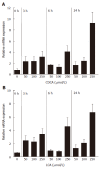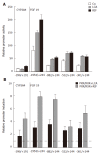Lithocholic acid induction of the FGF19 promoter in intestinal cells is mediated by PXR
- PMID: 17696253
- PMCID: PMC4250623
- DOI: 10.3748/wjg.v13.i31.4230
Lithocholic acid induction of the FGF19 promoter in intestinal cells is mediated by PXR
Abstract
Aim: To study the effect of the toxic secondary bile acid lithocholic acid (LCA) on the expression of fibroblast growth factor 19 (FGF19) in intestinal cells and to characterize the pregnane-X-receptor (PXR) response of the FGF19 promoter region.
Methods: The intestinal cell line LS174T was stimulated with various concentrations of chenodeoxy-cholic acid and lithocholic acid for several time points. FGF19 mRNA levels were determined with quantitative realtime RT-PCR. FGF19 deletion promoter constructs were generated and the LCA response was analzyed in reporter assays. Co-transfections with PXR and RXR were carried out to study FGF19 regulation by these factors.
Results: LCA and CDCA strongly up-regulate FGF19 mRNA expression in LS174T cells in a time and dose dependent manner. Using reporter gene assays with several deletion constructs we found that the LCA responsive element in the human FGF19 promoter maps to the proximal regulatory region containing two potential binding sites for PXR. Overexpression of PXR and its dimerization partner retinoid X receptor (RXR) and stimulation with LCA or the potent PXR ligand rifampicin leads to a significant induction of FGF19 promoter activity in intestinal cells.
Conclusion: LCA induced feedback inhibition of bile acid synthesis in the liver is likely to be regulated by PXR inducing intestinal FGF19 expression.
Figures



Similar articles
-
Involvement of multiple elements in FXR-mediated transcriptional activation of FGF19.J Steroid Biochem Mol Biol. 2012 Oct;132(1-2):41-7. doi: 10.1016/j.jsbmb.2012.04.008. Epub 2012 May 3. J Steroid Biochem Mol Biol. 2012. PMID: 22561792
-
Pregnane X receptor mediated-transcription regulation of CYP3A by glycyrrhizin: a possible mechanism for its hepatoprotective property against lithocholic acid-induced injury.Chem Biol Interact. 2012 Oct 25;200(1):11-20. doi: 10.1016/j.cbi.2012.08.023. Epub 2012 Sep 13. Chem Biol Interact. 2012. PMID: 22982774
-
Intestinal detoxification limits the activation of hepatic pregnane X receptor by lithocholic acid.Drug Metab Dispos. 2010 Jan;38(1):143-9. doi: 10.1124/dmd.109.029306. Drug Metab Dispos. 2010. PMID: 19797606 Free PMC article.
-
The Effect of Lithocholic Acid on the Gut-Liver Axis.Front Pharmacol. 2022 Jul 7;13:910493. doi: 10.3389/fphar.2022.910493. eCollection 2022. Front Pharmacol. 2022. PMID: 35873546 Free PMC article. Review.
-
Developments in the study of gastrointestinal microbiome disorders affected by FGF19 in the occurrence and development of colorectal neoplasms.J Cell Physiol. 2020 May;235(5):4060-4069. doi: 10.1002/jcp.29322. Epub 2019 Oct 21. J Cell Physiol. 2020. PMID: 31637718 Review.
Cited by
-
Bile Acid Metabolism and Signaling in Cholestasis, Inflammation, and Cancer.Adv Pharmacol. 2015;74:263-302. doi: 10.1016/bs.apha.2015.04.003. Epub 2015 May 27. Adv Pharmacol. 2015. PMID: 26233910 Free PMC article. Review.
-
Tanshinone IIA ameliorates dextran sulfate sodium-induced inflammatory bowel disease via the pregnane X receptor.Drug Des Devel Ther. 2015 Dec 7;9:6343-62. doi: 10.2147/DDDT.S79388. eCollection 2015. Drug Des Devel Ther. 2015. PMID: 26674743 Free PMC article.
-
Comparative potency of obeticholic acid and natural bile acids on FXR in hepatic and intestinal in vitro cell models.Pharmacol Res Perspect. 2017 Dec;5(6):e00368. doi: 10.1002/prp2.368. Pharmacol Res Perspect. 2017. PMID: 29226620 Free PMC article.
-
Pharmacological Activation of PXR and CAR Downregulates Distinct Bile Acid-Metabolizing Intestinal Bacteria and Alters Bile Acid Homeostasis.Toxicol Sci. 2019 Mar 1;168(1):40-60. doi: 10.1093/toxsci/kfy271. Toxicol Sci. 2019. PMID: 30407581 Free PMC article.
-
Upregulation of hepatic bile acid synthesis via fibroblast growth factor 19 is defective in gallstone disease but functional in overweight individuals.United European Gastroenterol J. 2014 Jun;2(3):216-25. doi: 10.1177/2050640614527938. United European Gastroenterol J. 2014. PMID: 25360305 Free PMC article.
References
-
- Makishima M, Okamoto AY, Repa JJ, Tu H, Learned RM, Luk A, Hull MV, Lustig KD, Mangelsdorf DJ, Shan B. Identification of a nuclear receptor for bile acids. Science. 1999;284:1362–1365. - PubMed
-
- Parks DJ, Blanchard SG, Bledsoe RK, Chandra G, Consler TG, Kliewer SA, Stimmel JB, Willson TM, Zavacki AM, Moore DD, et al. Bile acids: natural ligands for an orphan nuclear receptor. Science. 1999;284:1365–1368. - PubMed
-
- Wang H, Chen J, Hollister K, Sowers LC, Forman BM. Endogenous bile acids are ligands for the nuclear receptor FXR/BAR. Mol Cell. 1999;3:543–553. - PubMed
-
- Goodwin B, Jones SA, Price RR, Watson MA, McKee DD, Moore LB, Galardi C, Wilson JG, Lewis MC, Roth ME, et al. A regulatory cascade of the nuclear receptors FXR, SHP-1, and LRH-1 represses bile acid biosynthesis. Mol Cell. 2000;6:517–526. - PubMed
-
- Lu TT, Makishima M, Repa JJ, Schoonjans K, Kerr TA, Auwerx J, Mangelsdorf DJ. Molecular basis for feedback regulation of bile acid synthesis by nuclear receptors. Mol Cell. 2000;6:507–515. - PubMed
Publication types
MeSH terms
Substances
LinkOut - more resources
Full Text Sources
Other Literature Sources
Research Materials

